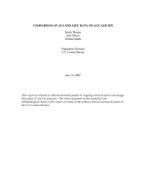
An official website of the United States government
Here’s how you know
Official websites use .gov
A .gov website belongs to an official government organization in the United States.
Secure .gov websites use HTTPS
A lock (
) or https:// means you’ve safely connected to the .gov website. Share sensitive information only on official, secure websites.
-
//
- Census.gov /
- Library /
- Census Working Papers /
- Comparison of ACS and ASEC Data on Age and Sex
Comparison of ACS and ASEC Data on Age and Sex
Comparison of ACS and ASEC Data on Age and Sex
Introduction
This report compares national age and sex distributions based on data from the 2004 American Community Survey (ACS) with those based on data from the 2004 Annual Social and Economic Supplement (ASEC) to the Current Population Survey. In this analysis, we compare the 2004 ACS and the 2004 ASEC distributions, look for differences that are both statistically and substantively different and, for those found, offer possible explanations.
It is important to note that the age and sex data from the ACS and the ASEC are controlled to intercensal population estimates of sex, age, race, and Hispanic origin. The intercensal population estimates are used as a method to calibrate both surveys, thereby creating sex, age, race, and Hispanic origin distributions that are reflective of a demographic framework of population accounting. Under this framework, the intercensal population estimates are based on the previous decennial census enumeration and the incorporation of data representing components of population change – births, deaths, and net migration. While this paper contains a description of differences between the two surveys in data collection methodology, item nonresponse, and data editing and imputation, the fact that the age and sex data are controlled to intercensal population estimates for the universe utilized by each survey, exerts the strongest influence on the resulting distributions. Thus, the overall result is that both the ACS and the ASEC have similar age and sex distributions, although there are a few statistically significant differences.
Others in Series
Working Paper
Working Paper
Working Paper
Share
Some content on this site is available in several different electronic formats. Some of the files may require a plug-in or additional software to view.
 Yes
Yes
 No
NoComments or suggestions?


Top


